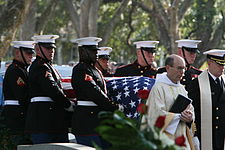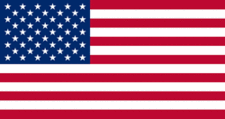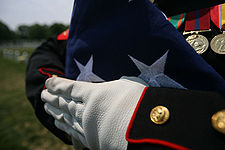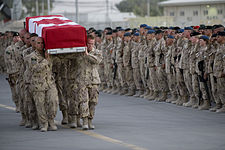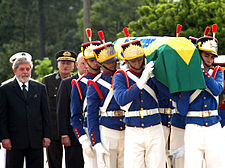- Military funeral
-
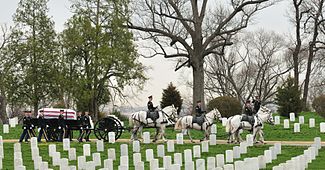 The United States Army Caisson Platoon of the 3rd United States Infantry Regiment "The Old Guard" transports the flag-draped casket of Sergeant Major of the Army George W. Dunaway on a horse-drawn limbers and caissons during a military funeral procession at Arlington National Cemetery, 2008.
The United States Army Caisson Platoon of the 3rd United States Infantry Regiment "The Old Guard" transports the flag-draped casket of Sergeant Major of the Army George W. Dunaway on a horse-drawn limbers and caissons during a military funeral procession at Arlington National Cemetery, 2008.
A military funeral is a specially orchestrated funeral given by a country's military for a soldier, sailor, marine or airman who died in battle, a veteran, or other prominent military figures or heads of state. A military funeral may feature guards of honor, the firing of volley shots as a salute, drumming and other military elements, with a flag draping over the coffin. On occasion, deceased soldiers have been accorded military funerals by their enemies (for example, see Manfred von Richthofen).
Contents
United States
See also: State funerals in the United StatesIn the United States, the United States Army Military District of Washington (MDW) is responsible for providing military funerals. "Honoring Those Who Served" is the title of the program for instituting a dignified military funeral with full honors to the nation's veterans.
As of January 1, 2000, Section 578 of Public Law 106-65 of the National Defense Authorization Act mandates that the United States Armed Forces shall provide the rendering of honors in a military funeral for any eligible veteran if requested by his or her family. As mandated by federal law, an honor guard detail for the burial of an eligible veteran shall consist of no less than two members of the Armed Forces. One member of the detail shall be a representative of the parent armed service of the deceased veteran. The honor guard detail will, at a minimum, perform a ceremony that includes the folding and presenting of the flag of the United States to the next of kin and the playing of Taps which will be played by a lone bugler, if available, or by audio recording. Today, there are so few buglers available that the United States Armed Forces often cannot provide one.[1] However, federal law allows Reserve and National Guard units to assist with funeral honors duty when necessary.
Eligibility
A military chaplain seen leading honor guards derived from the United States Marine Corps as they carry the casket of General Robert H. Barrow to the place of burial.
Generally, federal law allows for military funeral honors for all veterans who were discharged under circumstances "other than dishonorable." Funeral directors will require the veteran's DD Form 214 to establish eligibility.[2]
Those who are eligible for military funerals and full honors in the United States include the following:[3]
- Active duty or Selected Reserve in the United States Armed Forces.
- Former active duty who departed under conditions other than dishonorable in the United States Armed Forces.
- Former enlisted servicemen or servicewomen who completed at least one term or period of initial obligated service in the Selected Reserve and departed under conditions other than dishonorable.
- Former servicemen or servicewomen who were discharged from the Selected Reserve due to a disability incurred or aggravated in the line of duty.
Components
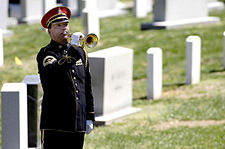 A bugler sounds Taps during the funeral of former United States Secretary of Defense Caspar W. Weinberger in Arlington National Cemetery, 2006.
A bugler sounds Taps during the funeral of former United States Secretary of Defense Caspar W. Weinberger in Arlington National Cemetery, 2006.
 Escort platoons marching during the military funeral of Admiral Thomas Hinman Moorer in Arlington National Cemetery, 2004.
Escort platoons marching during the military funeral of Admiral Thomas Hinman Moorer in Arlington National Cemetery, 2004.
In the United States, there are several types of military funerals such as those performed at Arlington National Cemetery, which include and omit certain components depending on the status of the deceased (active, retired, veteran, rank/occupation).[4]
Standard honor military funerals include the following:
- A military chaplain for family members.
- A casket draped in the flag of the United States and as a pall.
- A casket team serving as honor guards in a ceremonial role over the remains and as pallbearers.
- For funerals of service members with a non-commissioned grade of E-9 and above, the casket is transported via a horse-drawn limbers and caissons. For all other funerals, the casket is transported using a hearse.
- Fighter jets in missing man formation by the United States Air Force may perform an aerial flyover.
- The formation of a rifle party consisting of an odd number of service members, between 3 to 7, will fire a three-volley salute (size varies according to the rank of the deceased).
- The playing of Taps is performed by a lone bugler or an audio recording, at a distance 30 to 50 yards from the grave site while a “Final Salute” is given.
Full honor military funerals include all standard honors in addition to the following:
- For funerals of commanding officers of O-6 (Colonel/Captain) and above, a caparisoned, riderless horse, symbolizing a fallen leader, will follow the limbers and caissons.
- For funerals of general officers and flag officers of O-10 (four-star rank), a 17 gun salute is fired; O-9 (three-star rank), a 15 gun salute is fired; O-8 (two-star rank), a 13 gun salute is fired; O-7 (one-star rank), a 11 gun salute is fired.
- A military band and an escort platoon participate (size varies according to the rank of the deceased).
Armed forces military funerals include all standard and full honors in addition to the following:
- Escort platoons from all five branches of the United States Armed Forces participate.
- These funerals are reserved for the President of the United States (as commander-in-chief), the Secretary of Defense, the Chairman of the Joint Chiefs of Staff, and officers granted multiple-service command.
- For funerals of presidents, a 21 gun salute using artillery and battery pieces is fired (not to be confused with a three-volley salute), while all other high state officials receive 19 gun salutes.
When a spouse or other dependent of a current or former member of the United States Armed Forces is buried, the military service in which the primary party served will provide a casket team and a chaplain. No other military honors will be rendered unless the spouse served in the military.
Flag folding
 Sailors from the United States Navy fold the flag of the United States during a military funeral at Arlington National Cemetery for Captain Laurie Mosolino, a former United States Navy Medical Corps surgeon.
Sailors from the United States Navy fold the flag of the United States during a military funeral at Arlington National Cemetery for Captain Laurie Mosolino, a former United States Navy Medical Corps surgeon.
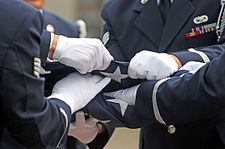 Members of the 86th Airlift Wing honor guard conduct a flag-folding ceremony at Ramstein Air Base, Germany, 2009.
Members of the 86th Airlift Wing honor guard conduct a flag-folding ceremony at Ramstein Air Base, Germany, 2009.
The flag of the United States draped over the casket is meticulously folded twelve times by a total of six honor guards, three on each side of the casket. The following information describes the symbolic meaning for each fold of the flag.[5] It is important to note that the twelfthfold procedure was a common practice long before the creation of a ceremonial assignation of "meaning" to each of the steps. Such symbolism has been mistakenly attributed to have an integral part in the origins of the twelfthfold procedure. In truth, it evolved as a means of providing religious significance to the ceremony and its participants, and is often requested to be read alongside the folding of the flag at funerals.[6]
Fold Meaning Fold One Life on Earth[7][8][9] Fold Two Eternal Life[7][8][9] Fold Three The veteran who gave a portion of his life for the defense of the United States[7][8][9] Fold Four Humanity's Weaker Nature and the American's reliance on God during both peacetime and wartime[7][8][9] Fold Five Tribute to our Country[7][8][9] Fold Six The state of the American's heart[7][8][9] Fold Seven The United States Armed Forces[7][8][9] Fold Eight Tribute to the one who entered into the valley of the shadow of death, that humanity might see the light of day[7][8][9] Fold Nine A tribute to Motherhood[7][8][9] Fold Ten A tribute to Fatherhood[7][8][9] Fold Eleven The eleventh fold, in the eyes of a Jewish citizen, represents the lower portion of the seal of King David and King Solomon, and glorifies, in their eyes, the God of Abraham, Isaac, and Jacob.[7][8][9] Fold Twelve The twelfth fold, in the eyes of a Christian citizen, represents an emblem of eternity and glorifies, in their eyes, God the Father, the Son, and Holy Ghost.[7][8][9] Often, three spent shell-casings, each representing one of three volleys, are slipped into the folds of the flag before its presentation to the next of kin.[10][11] When the flag is completely folded, the stars point upwards, which remind Americans of their national motto, In God We Trust.[8][9][12] After the flag is completely folded and tucked in, it takes on the appearance of a bicorne hat, reminding Americans of the soldiers who served under General George Washington, and the sailors and Marines who served under Captain John Paul Jones, who were followed by their comrades and shipmates in the United States Armed Forces.[8][9][12]
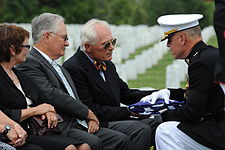 Inspector General of the Marine Corps Brigadier General Kenneth J. Lee presents a folded flag to Ralph H. Pope, the eldest son of Medal of Honor recipient Major Everett Pope during the burial service for Major Pope held at Arlington National Cemetery on September 15, 2009.
Inspector General of the Marine Corps Brigadier General Kenneth J. Lee presents a folded flag to Ralph H. Pope, the eldest son of Medal of Honor recipient Major Everett Pope during the burial service for Major Pope held at Arlington National Cemetery on September 15, 2009.
Flag presentation
Thereafter, an honor guard representing one of the five branches of the United States Armed Forces will present the flag to the next of kin by kneeling in front of the recipient, holding the folded flag waist high with the straight edge facing the recipient, while leaning toward the recipient. Depending on the service of the selected honor guard chosen to present the flag to the next of kin, each of the five military branches uses slightly different wording.[13]
An honor guard representing the United States Army would present the flag to the next of kin by saying:[13]
“ On behalf of the President of the United States and the people of a grateful nation, may I present this flag as a token of appreciation for the honorable and faithful service your loved one rendered this nation. ” - (NOTE: President of the United States isn't an official reference in the Army flag presentation. In this case, the honor guard would say: "This flag is presented on behalf of a grateful nation and the United States Army as a token of appreciation for your loved one's honorable and faithful service.")[14]
An honor guard representing the United States Marine Corps would present the flag to the next of kin by saying:[13]
“ On behalf of the President of the United States, the Commandant of the Marine Corps, and a grateful nation, please accept this flag as a symbol of our appreciation for your loved one's service to Country and Corps. ” An honor guard representing the United States Navy would present the flag to the next of kin by saying:[13]
“ On behalf of the President of the United States and the Chief of Naval Operations, please accept this flag as a symbol of our appreciation for your loved one's service to this Country and a grateful Navy. ” An honor guard representing the United States Air Force would present the flag to the next of kin by saying:[13]
“ On behalf of the President of the United States, the Department of the Air Force, and a grateful nation, we offer this flag for the faithful and dedicated service of (Service member's rank and name). ” - (NOTE: If the next-of-kin has expressed a religious preference or belief, the Air Force honor guard will add: "God bless you and this family, and God bless the United States of America.")
An honor guard representing the United States Coast Guard would present the flag to the next of kin by saying:[13]
“ On behalf of the President of the United States, the Commandant of the Coast Guard, and a grateful nation, please accept this flag as a symbol of our appreciation for your loved one's service to Country and the Coast Guard. ” Gallery
-
The military funeral of U.S. Navy Rear Admiral Henry H. Bell held in Hiogo, Japan on January 14, 1868.
-
Members of the Presidential Salute Guns Battery of the 3rd United States Infantry Regiment "The Old Guard" render a gun salute using three-inch anti-tank guns (modified to 75mm caliber) during a military funeral held at Arlington National Cemetery on August 10, 1998.
-
A casket team from the 1st Special Forces Group carry the flag-draped casket of Sergeant 1st Class Nathan R. Chapman on January 8, 2002 at Seattle-Tacoma International Airport.
-
A casket team from the United States Navy fold the flag covering the remains of NASA Astronaut and U.S. Navy Captain Laurel Blair Salton Clark, a crew member of the Space Shuttle Columbia who perished with the rest of her crewmates during the Space Shuttle Columbia disaster in 2003.
-
The casket of Caspar Weinberger, 15th United States Secretary of Defense, in a ceremonial funeral procession enroute to its final resting place in Arlington National Cemetery on April 4, 2006.
-
A casket team from the 3rd United States Infantry Regiment "The Old Guard" transports the remains of Retired Chief Warrant Officer Michael J. Novosel during a ceremonial funeral procession at Arlington National Cemetery where he was laid to rest on April 13, 2006.
-
The Ceremonial Unit assigned to Naval Air Station Lemoore seen rendering honors at a military funeral at San Joaquin Valley National Cemetery in Gustine, California.
-
Escort platoons march in the United States Naval Academy Cemetery as part of the ceremonial funeral procession for former Chairman of the Joint Chiefs of Staff, Admiral William J. Crowe in 2007.
-
A casket team carries Major Douglas A. Zembiec, former commander of E Company, 2nd Battalion, 1st Marine Regiment from the Naval Academy Chapel in Annapolis, Maryland following a funeral service held in his honor.
Worldwide
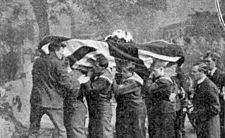 The coffin of Lieutenant Reginald Warneford being carried to his burial plot in Brompton Cemetery by members of the Royal Naval Division, June 21, 1915.
The coffin of Lieutenant Reginald Warneford being carried to his burial plot in Brompton Cemetery by members of the Royal Naval Division, June 21, 1915.
- The British army carries reversed arms at military funerals.
- Canadian military funerals involve many rituals seen in other parts of the world. The Royal Canadian Horse Artillery use a 25-pounder gun and limber as the funeral vehicle.
- Muffled drums accompany the graveside processional.
- The deceased's headdress, insignia and medals are borne on a velvet cushion into the funeral service .
- Volleys are fired over the grave when the body is interred.
- Countries in the Commonwealth duplicate the British military drill and ceremony. The Canadian funeral described above typifies the funerary service.
- In Germany, Ludwig Uhland's song "Ich hatt' einen Kameraden" is an integral part of a military funeral. In Chilean military funerals, due to its Prussian military tradition, this song is also sung.
- After the 2006 Lebanon war, Hezbollah draped coffins containing their dead in Hezbollah flags with flowers on top. They were given a funeral according to Shiite Muslim traditions, then buried in their hometowns.
- In Indonesia, military funerals are generally given only military members or former guerrillas, Konfrontasi and Trikora Operation Soldiers, especially those holding the Bintang Gerilya (Star of the Guerrilla). Exceptional politicians and Ministers have the option for such a funeral, but most opt for a more intimate religious one.
- Music is not performed as it is not part of Indonesian military tradition.
- A 21-gun volley salute is the norm by seven soldiers- occasionally a mixture of armed forces dependent on their career,[15]
- Honour drill team is platoon-size formation and larger the more illustrious the departed. A good example of an Indonesian military burial is that of the late president Suharto- (although obvious major differences exist)
- In Poland, the last fragment of Władysław Tarnowski's song Śpij, kolego ("Sleep, friend"),[16][17][18] a portion of the larger composition Jak to na wojence ładnie (the title has no precise English translation, but it is roughly "how nice it is in war", with a diminutive form conveying a sense of ironic solidarity)[19] is an integral part of a military funeral.
- In Spain, the formed troops sing "La muerte no es el final": Death is not the End.
Ramp ceremonies
The term "ramp ceremony" has, since about 2005 and during the wars in Iraq and Afghanistan, come to have a particular meaning - that of a solemn memorial ceremony for a coalition soldier killed in a war zone. The ceremony usually takes place at an airfield near or in a war zone, where an airplane is usually waiting nearby to take the soldier's remains to his or her home country.[20] A ramp ceremony is not an actual funeral; the funeral is usually conducted in the deceased's home country.
References
- ^ "What is Military Funeral Honors?". U.S. Department of Defense. http://www.militaryfuneralhonors.osd.mil/faqpage.html.
- ^ "How do I establish veteran eligibility?". U.S. Department of Defense. http://www.militaryfuneralhonors.osd.mil/eligpage.html.
- ^ "Who is eligible for Military Funeral Honors?". U.S. Department of Defense. http://www.militaryfuneralhonors.osd.mil/eligpage.html.
- ^ "Ceremonies". Arlington National Cemetery. http://www.arlingtoncemetery.mil/ceremonies/military_funerals.html.
- ^ "Military Funeral Customs". http://www.huachuca.army.mil/pages/garrison/directorates/DHR/CAC/docs/Military%20Funeral%20Honors%20Customs.pdf.
- ^ "Symbolism of the thirteen-fold procedure". http://www.snopes.com/military/flagfold.asp.
- ^ a b c d e f g h i j k l "Flag Folding". US Flag. http://www.usflag.org/foldflag.html. Retrieved 2007–10–18.
- ^ a b c d e f g h i j k l m n "Flag folding procedures and symbols". American Legion. http://www.legion.org/flag/folding. Retrieved 2007–10–18.
- ^ a b c d e f g h i j k l m n Carlos Zamorano. God Bless America. Xlibris, Corp.. http://books.google.com/books?id=lti2VdlRkxEC&pg=PA128&dq=Flag+Folding++meaning&hl=en&ei=6pRXTerrLcSgtwfip9XbDA&sa=X&oi=book_result&ct=result&resnum=1&ved=0CEAQ6AEwAA#v=onepage&q=Flag%20Folding%20%20meaning&f=false. Retrieved 2007–10–18.
- ^ "What do the three bullets represent in military funerals?". About.com. http://usmilitary.about.com/od/theorderlyroom/f/funeralhonors.htm.
- ^ "Honor Guard". Byron.org. http://www.byron.org/VFW/HonorGuard.htm.
- ^ a b "Flag Folding". US Flag. http://www.usflag.org/foldflag.html. Retrieved 2011–05–16.
- ^ a b c d e f "Flag Folding and Presentation Protocol". http://www.mfhcmdrs.osd.mil/mfhcr_edu_present.htm.
- ^ "Flag Presentation Protocol". USA Patriotism!. http://www.usa-patriotism.com/reference/flag_presentation.htm.
- ^ (example- a Minister of Transportation may have been a career Army soldier, became a bureaucrat and assisted the national aviation or maritime industry- thus the corresponding Force would send soldiers as gratitude)
- ^ "Śpij, kolego (score)". Polish Army WEB. http://www.wojsko-polskie.pl/download/tmp/2009-12-11/fd20e7a68a696a973ecff32cd6791a0a06%20-%20śpij%20kolego.pdf. Retrieved 14 December 2009.
- ^ "Śpij, kolego (mp3)". Polish Army WEB. http://www.wojsko-polskie.pl/mobjects/view/46752,13f+%C5%9Bpij+kolego.mp3.html. Retrieved 14 December 2009.
- ^ Polish text "Jak to na wojence ładnie". http://pl.wikisource.org/wiki/Jak_to_na_wojence_%C5%82adnie. Retrieved 3 August 2009.
- ^ "Jak to na wojence ładnie mp3". http://odsiebie.com/pokaz/2124148---618f.html. Retrieved 3 August 2009.
- ^ Conrad, John D. (2009). What the thunder said: reflections of a Canadian officer in Kandahar. p. 162. ISBN 155488408X, 9781554884087. http://books.google.com/books?id=3VElVkyY0eIC&pg=PA162&dq=%22ramp+ceremony%22#v=onepage&q=%22ramp%20ceremony%22&f=false. Retrieved 7 July 2010.
Further reading
- Mossman, B.C.; Stark, M.W. (1991). The Last Salute: Civil and Military Funerals 1921-1969. Washington, D.C.: Department of the Army. CMH Pub 90-1. http://www.history.army.mil/books/Last_Salute/Index.htm.
Images and sounds
External links
Categories:- Military life
- Military traditions
- State ritual and ceremonies
- Funerals
Wikimedia Foundation. 2010.

